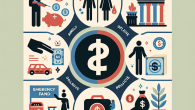
Passive Income for Beginners: My Top 5 UK Strategies That Actually Work
Why You Don’t Need to Be Rich to Start Investing — A Step-by-Step Guide
Spoiler alert: You don’t need six figures or a finance degree to start investing. Seriously — ditch that myth ASAP. Hi, I’m Rachel Simmons. I’m not your typical finance advisor in a corporate suit. I’m just a coffee-loving, spreadsheet-obsessed woman who turned her humble paycheck into a life of financial independence. And you can too — no trust fund required.
If you’ve been telling yourself “I’ll start investing when I make more money,” you’re not alone — but you’re also not doing yourself any favors. Here’s the truth: the best time to start investing was yesterday; the second-best is today. So grab a cup of tea (or wine, zero judgment) and let’s break this down together.
What Does “Investing” Even Mean?
Let’s get rid of the finance jargon first. Investing simply means putting your money somewhere it can grow over time. Think of it like planting a money tree — slowly watering it, letting the sun do its thing, and one day, boom: financial fruit everywhere.
Instead of leaving your money sitting in a low-interest savings account (where it actually loses value thanks to inflation), you put it into things like stocks, bonds, ETFs, or real estate — things that have the potential to grow.
But I’m Broke… How Can I Invest?
Been there. I used to think my $200 in savings meant I couldn’t touch the “big league” of building wealth. Wrong. So wrong. Today, you can start investing with as little as $5 — some apps even offer fractional shares, which I’ll get to in a minute.
Step 1: Mindset Makeover
You don’t need to “have money” — you need to make investing a habit, not a luxury. Even investing $25/month consistently is better than waiting until you have a mythical $5,000 lying around. Compound interest doesn’t care how rich you are — it only cares how early you start.
Step 2: Emergency Fund Comes First
Before investing, make sure you’ve got some money reserved for emergencies. Ideally, 3–6 months of essential expenses. If your car breaks down or you lose your job, you don’t want to be selling stocks when the market’s having a meltdown.
Step 3: Pay Off High-Interest Debt
Got credit card debt over 15% interest? That beast needs to go. Paying off high-interest debt is like earning a guaranteed return. Once you’re down to stable, manageable debt (like student loans or a mortgage), it’s time to invest.
Where Can You Start Investing With Little Money?
Yes, there are platforms that welcome us mere mortals with tiny wallets. Let me introduce you to a few favorites of mine:
- Fidelity: No account minimums and a solid selection of zero-commission ETFs and mutual funds.
- Vanguard: Great for index funds, though some initial investments start at $1,000 (still reasonable if you’re ready).
- M1 Finance: Offers fractional shares and automated investing, like having your own robo-butler.
- Acorns: Rounds up your purchases and invests the spare change. Ideal for beginners who want autopilot mode.
And no, I’m not sponsored — just wildly enthusiastic about tools that make personal investing accessible to everyone.
What Should You Invest In?
Here’s where people freak out. Stocks? Bonds? Crypto? Relax. I’ve got you.
If you’re new to the game and want simplicity and stability, start here:
- Index Funds & ETFs: These are bundles of many stocks, so you reduce your risk. It’s like ordering the sampler platter instead of picking one mystery dish.
- Target-Date Funds: Got a retirement date in mind? Target-date funds adjust over time based on how close you are to that date — less hands-on, more cozy autopilot vibes.
- Robo-Advisors: Services like Betterment and Wealthfront build and manage a portfolio for you based on your risk tolerance.
Still confused? Don’t worry. Pick one method, start with a small amount, and tweak later if needed. The biggest mistake is doing nothing.
How to Build Your First Portfolio (Without Losing Your Sanity)
Let’s pretend you’ve got $100 to start. Here’s a sample breakdown for a newbie investor in her 20s aiming for long-term freedom:
- 70% in a Total Market ETF — like VTI (U.S. market) or VT (global)
- 20% in a Bond ETF — think BND for a bit of stability
- 10% in Fun Money — this is your “play fund” for individual stocks you’re curious about
The important part? Consistency beats timing. You don’t need to watch the market like hawks track prey. Just automate your investments monthly, and live your fabulous life.
Common Investing Myths That Need to Die (Today)
Myth #1: Investing Is Only for the Wealthy
Tell that to my college self who started investing with literally $50. Seriously, this one’s gotta go.
Myth #2: You Need to Be a Finance Expert
Trust me, you can be terrible at math and still build wealth. That’s what automated investing, index funds, and diversified portfolios are for.
Myth #3: The Stock Market Is Too Risky
Risk depends on how you invest, not if. Long-term investing with diversified funds is historically one of the most reliable wealth-building strategies out there.
Still Scared? That’s Okay. Do It Anyway.
I get it. Starting literally anything related to money can feel like playing Monopoly blindfolded. But here’s the magic: you don’t need to be perfect; you just need to begin.
Set up recurring investments. Track your progress once a month. Ignore the noise and fancy headlines. With time, patience and the willingness to learn, you’ll go from “I don’t know where to start” to “My money works for me.”
Your First Challenge:
Open an account with one of the platforms above. Invest $25 — just 25 bucks. That’s less than your last Uber Eats order. Then come back and tell yourself: “I’m officially an investor now.” Because you are.
Final Thoughts
You don’t need to be rich, smart, or lucky to invest. You just need to start. Small steps become big leaps when consistency is involved.
And hey, if you’re looking for more resources or need to reach out, head to our About Us page or drop me a message on Contact. No judgment, ever — just real talk and actionable advice.
To your beautifully imperfect, wildly powerful financial freedom,
– Rachel









Leave a Reply